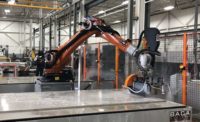Lapitec is a full-body sintered stone slab that comes in a variety of colors and finishes. It is also an extremely dense product which leads fabricators to wonder, “What are the options for tooling when working with the material?” The tools required for cutting Lapitec has to have some unique characteristics.
“The bonding alloy has to be resistant to the high stress of the cutting process, while at the same time, not being too hard to allow for continuous sharpening of the tools,” said John Taranto, vice president of architectural sales for ABC Stone of New York, NY. “The dimension of the diamond cannot be too coarse to reach the preferred finish on the edge and finally, the geometry of the tool has to help to cool perfectly.”
Lapitec can be processed in the same way, with the same tools that are used on natural stone. “The tools are already available on www.lapitools.com, the key component is the blade, all fabricators want a clean cut with minimal to no chatter / chipping on the edges, the Lapitec blade is what you want. All the fabricator needs to know is the RPM’s of the bridge-saw to order the correct blade. Some companies are developing tools specifically for Lapitec, or similar materials, but there’s no need for them,” said Taranto. “Lapitec is full-bodied so you can create endless edge profiles like an Ogee, Dupont, Waterfall, miter, etc., with either a CNC or doing it by hand with a common pad.” Lapitec’s textured surfaces can also be processed on the edge to replicate the surface. For example, their Vesuvio slabs can be replicated using a simple pneumatic granite bushhammer and a brushing tool that would be used for granite.
After you get the appropriate tools, there are still a few other key points to follow to get perfect results. “The feed rate must match what is suggested by the supplier, which is Lapitec in this case,” said Taranto. “Any big variation in both directions, too fast or too slow, will damage the material and tools. Running too slow doesn’t allow the blade to be correctly sharpened during the cutting process. Water must be very well directed to the diamond. We normally suggest an extended flexible pipe so the tools don’t get overheated while cutting. The slabs must lay on a solid and even support to avoid vibration that can cause chips or empty space, a void, under the pieces that could cause cracks.”
Any questions a fabricator has about the project, can be found in the company’s comprehensive fabrication manual that will answer just about any question or concern. “We are not trying to teach the experts on how to fabricate, we are only assisting them on understanding the material,” said Taranto. “It must be recognized as a new material category. Comparing some of the durability’s that are similar to high-impact porcelain, although the fabrication aspects are very different and mostly comparable to natural stone.”
Lapitec was specifically designed for exterior applications, giving it many possibilities for projects. “The fact that Lapitec can be cut-to-size as natural stone is a game changer in itself,” said Taranto. “Lapitec can be used for facades, as well as roofing applications. To add, Lapitec had the environment and the health and well-being of those fabricating the material, they have developed the first silica-free material and soon all of our colors will be 100% silica free. Lapitec also developed the first through-body vein with their Arabescato line, which is a veining that is not controlled just like a natural stone in some sense, and now introduced our second generations through-body vein, the Artistica Collection, which is book-matched and a controlled vein, now providing the ability to design continuous veining on different applications. Environmentally, the material only uses 100% natural minerals and organic coloring. Lapitec is fully recyclable, which means the material can be reprocessed and have minimal to no waste in production. Lapitec has less than 4% waste overall at the facility in Italy.”




















